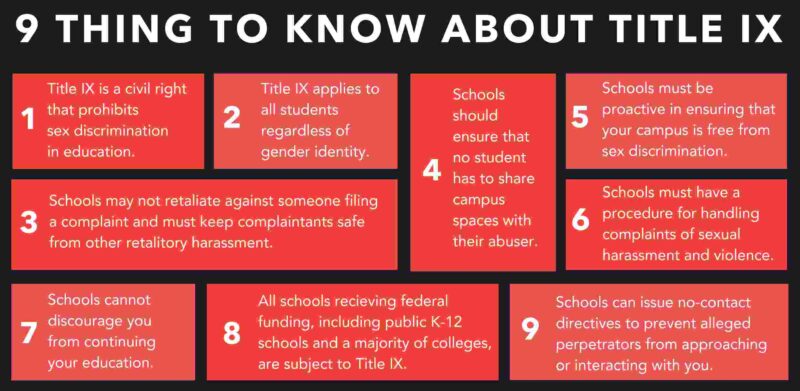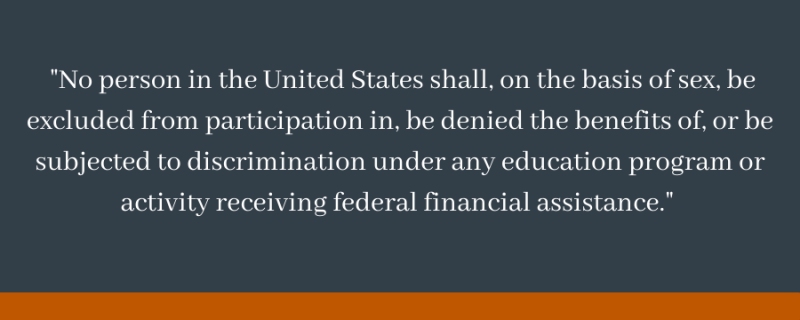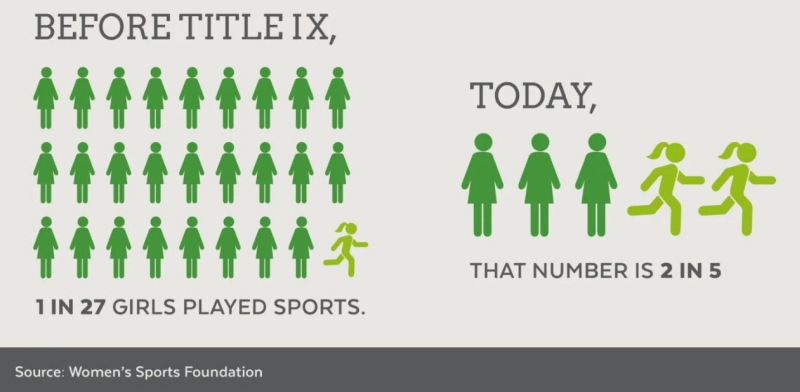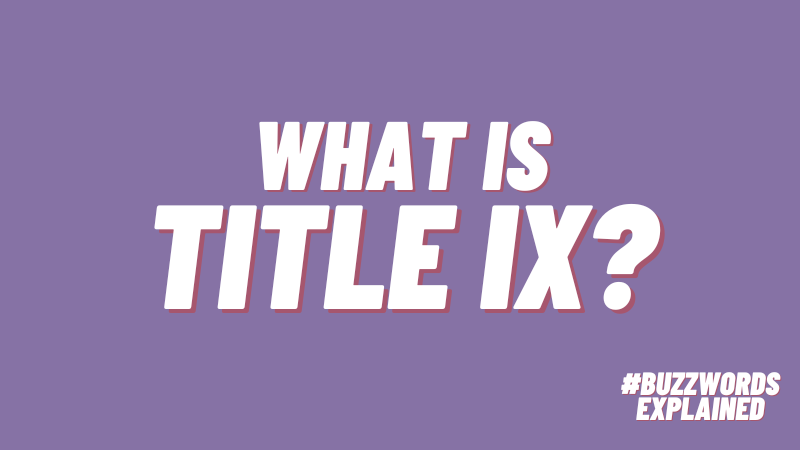When most people hear “Title IX,” they immediately think of school sports for girls and women. But that’s only a small part of what this important law entails. Discover the details of what this legislation says and means and who it protects.
What is Title IX?

Source: Hallmark University
This landmark legislation (sometimes written as “Title 9”) changed the face of education in a variety of ways by banning gender discrimination in any educational institution receiving federal funding. This includes all public schools and many private ones. It also includes educational programs run or funded by federal organizations, like a corrections facility, library, museum, or national park. In short, if any part of an educational program’s funding comes from the federal government, Title IX applies.
While this law is frequently associated with the expansion of women’s sports programs, it also has other important impacts. Organizations under its purview must make their activities, classes, and programs available to all, regardless of sex or gender.
Title IX defines discrimination on the basis of sex to include sexual harassment or sexual violence, such as rape, sexual assault, sexual battery, and sexual coercion. Title IX institutions must respond promptly to complaints of any type of sexual or gender discrimination.
Discover more details about Title IX here.
History of Title IX
When Congress passed the Civil Rights Act of 1964, it banned many forms of discrimination in employment but didn’t directly address education. Another law, Title VI, did ban discrimination in education based on race, color, or national origin. Gender or sex-based discrimination, though, wasn’t specifically covered in any law.
In 1971, Senator Birch Bayh first proposed the legislation, and it passed in 1972. Representative Patsy Mink took the lead in protecting the law from being weakened in its language and intent. When she died in 2002, the law was officially renamed the Patsy T. Mink Equal Opportunity in Education Act. It’s still generally referred to as Title IX in legal and educational circles.
Read more about the history of Title IX here.
What the Law Says

Source: The University of Texas at Austin
Title IX begins with these key words:
“No person in the United States shall, on the basis of sex, be excluded from participation in, be denied the benefits of, or be subjected to discrimination under any education program or activity receiving federal financial assistance.”
The law goes on to list some exemptions, such as religious schools. See the complete text of Title IX here.
What does Title IX require schools to do?
Under this law, all affected schools and educational institutions must do the following:
- Offer all programs equally: Schools must ensure students of any gender have equal access to all its programs, including classes, extracurriculars, and sports.
- Appoint a Title IX Coordinator: This person (or group of people) is responsible for ensuring the organization is in compliance with the law at all times.
- Publish an antidiscrimination policy: The organization must create a policy stating that it does not discriminate on the basis of sex or gender in its educational programs and activities. This must be publicly published and widely available. Most schools include it in their student handbooks, at a minimum.
- Address sexual or gender harassment or violence: Schools must recognize and investigate all complaints of sexual or gender harassment or violence. Learn what this includes here.
- Establish complaint policies: Schools and other educational institutions must create a policy for students and employees to file complaints of sex or gender discrimination. It must include time frames and procedures for addressing and resolving such complaints.
Title IX and Sports

Source: The Harvard Gazette
When it was first proposed and the potential impacts became clear, Senator John Tower suggested an amendment that would exclude athletics programs from Title IX’s scope. This amendment was rejected, and ultimately the law led to huge changes in high school and college sports. These were one of the most visible signs of the law in action, and led to the common understanding of Title IX as a “sports law.” In truth, though, it encompasses a great deal more.
Later legal decisions clarified the legislation’s impact on sports. Schools don’t have to offer identical sports to all genders, but they must offer equal opportunities to participate. The quality of the programs, including facilities, coaches, and equipment, must be equal as well. If one gender is underrepresented in athletics programs, schools must show they are making an effort to expand their programs, or that their current programs meet the present demand.
Learn more about Title IX and athletics here.
Sexual Harassment and Violence
This law has also been applied to how schools deal with complaints of sexual harassment or violence. In 2011, the Department of Education’s Office of Civil Rights clarified this stance. It stated that all schools must “take immediate and effective steps to end sexual harassment and sexual violence.” Schools that did not address these issues stood to lose federal funding and could even be fined.
These policies have been applied differently throughout recent years, and it remains a controversial subject. However, at a minimum, schools must have policies in place prohibiting sexual harassment and violence. They must also promptly address all complaints using those policies.
Learn more about sexual harassment and violence policies here.
Does Title IX protect transgender students?
In the last decade, this has become a hotly debated subject. Some states have sought to ban transgender students from competing on gender-based sports teams that don’t match the gender they were assigned at birth. In many areas, transgender students and staff still face regular discrimination, harassment, and violence. This area of the law is still very much in flux—it’s changing day by day.
As of spring 2023, here’s where things stand. The U.S. Department of Education has directed schools (as of 2021) that Title IX protects students from discrimination based on gender identity. In April 2023, the DOE issued a notice of proposed rulemaking that “would establish that policies violate Title IX when they categorically ban transgender students from participating on sports teams consistent with their gender identity just because of who they are.” Whether this rule becomes law remains to be seen.
Regardless of the outcome of the proposed athletics changes, transgender students and educators are still protected from sexual discrimination, harassment, and violence. Learn more about these protections here.
What should students or educators do about potential Title IX violations?

Source: Novato Unified School District
If you feel you’ve been the victim of sexual or gender discrimination, harassment, or violence at school or in an educational setting, you’re entitled to make a complaint under Title IX. You can also make a complaint on behalf of someone else or report generalized behavior you’ve seen. If students make a complaint to a teacher or other school official, they’re required to escalate it to the appropriate higher-ups. It’s best to make your complaint in writing, keeping a copy for yourself. Learn how to file a complaint with the DOE Office for Civil Rights here.
The school or educational institution is required to respond promptly, according to the policies they have in place. There will usually be a hearing, in which both sides may make their case. Schools should follow their policies to make determinations and decide on any necessary disciplinary actions. Title IX hearings do not involve any outside law enforcement agencies, such as the police. You may still pursue any complaints you have regarding the situation in criminal or civil court, but they do not affect the school’s internal process.
Regardless of the outcome of any investigations, no one is allowed to retaliate against you for filing your complaint. However, there are many cases where schools do not comply with the law. If you feel this is the case, you have the right to seek legal action.
Explore more about Title IX violations and reporting here.
Have more questions about Title IX? Come talk it over with other educators in the WeAreTeachers HELPLINE group on Facebook.
Plus, read 9 Areas of Your Teaching to Evaluate for Diversity & Inclusion.


